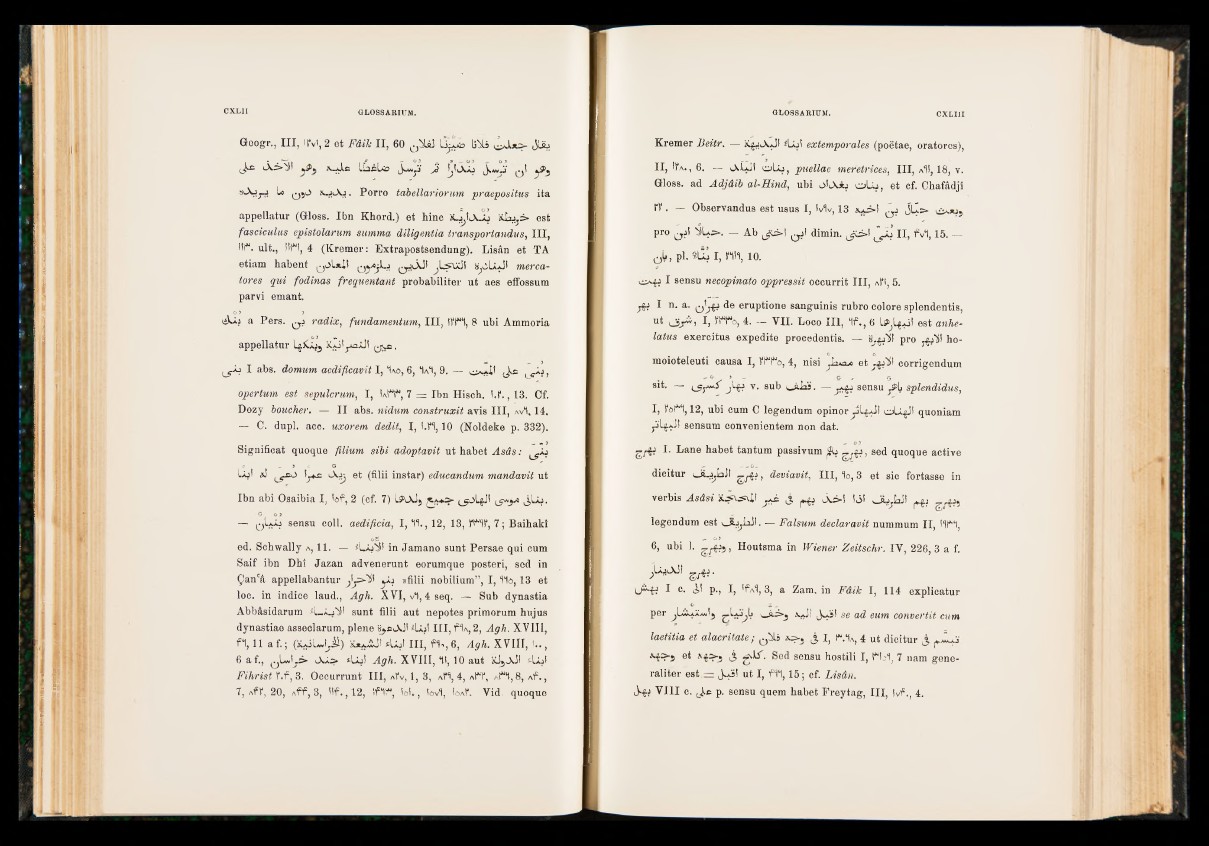
! ÿ v c
' Â: F V, ï :
IH
' U , .
- Â -
; '•■ .
i
l u : :
: ’
i
t i f y
‘ ' F
« ^ ! I'
f « r
I
CXLII ÖLOSSAEIUM.
Googi-., I I I , Ifvi,2 et Fâik I I , 60 ^jlU] I f x o IjlLi J y
(J e Â=>LI * y ,c LLicLàs Â^;7 ß ß X A ß f ö y l ^ 5
hvVjj-j Lo y j 0 s..jA j. Po ri'0 tabellariorum praepositus ita
app e lla tu r (Gloss. Ib n Khord.) e t hinc *-ÿA.Xj *Ljg=> est
fasciculus epistolarurn summa diligentia transporiandus, I I I ,
"fi. ult., "fil, 4 (K rem e r; E x trapostsendung). Lisân et TA
etiam h ab en t y jL x Il y y ^ - j ^J.AJI ^LyuJi »yLxJI mercatores
qui fodinas fréquentant p ro b ab ilite r u t aes effossum
parvi emant.
O 3 3
iAâj a Pers. y j radix, fundamentum, I I I , Iffil, 8 ubi Ammoria
03 w
ap p ellatu r IgJLxjj y v c .
y ß I abs. domum aedificavit I, Vo, 6, VI, 9. — ^0^*11 ^Jc , y ,
opertum est sepulcrum, I , Ufifi, 7 = Ib n Hisch. i . f . , 13. Cf.
Dozy boucher. — I I abs. nidum construxit avis I I I , a v I , 14.
— C. dupl. ace. uxorem dedit, I , t.fl, 10 (Noldeke p. 332).
Significat quoque filium sibi adoptavit u t h ab e t Asâs : yX;
5 E 3 î G
Lxjl aJ y c o îg £ e t (filii instar) educandum mandavit ut
Ibn abi Osaibia I, lof, 2 (cf. 7) L3>aJ} L5^Lf" S A -
— f y sensu coll. aedificia, I, U ., 12, 13, ffilf, 7; Baihakî
o£
ed. Schwally a , 1 1 . — iLXjLI in Jamano su n t Persae qui cum
Saif ibn Dhi Ja z an ad v eu e ru n t eorumque posteri, sod in
Ç an 'â appe llab an tu r ÿ »filii nobilium” , I, llo, 13 et
loo. in indice laud., Agh. X V I , vl, 4 seq. — Sub dy n astia
Abbâsidarum iL_X.jLI su n t filii au t nepotes primorum hujus
dynastiao asseclarum, plene BjcAil iLXjl I I I , f 1 a , 2, Agh. X V I I I ,
f l , 11 a f.; (ÄjLwLÜ) **aëJî 4Xj! I I I , fL , 6, Agh. X V I I I , ,
6 a f., yLwLÈ» AXe. tLx" Agh. X V I I I , H, 10 au t aJjAJI ^Lx"
Fihrist f .f , 3. Ocourrunt I I I , Afv, 1, 3, *f1, 4, ofif, ofil, 8, Af.,
7, Aff, 20, Aff, 3, " f . , 12, if Ifi, ioi., lovi, lôAf. Vid. quoque
GLOSSARIUM. CXLIII
Kremer Beitr. — y jA J I ïLXjI extemporales (poëtae, oratorcs),
I I , IfA., 6. — a L j I oLxj, puellae meretrices, I I I , aH, 18, v.
Gloss. ad Adjâib al-Hind, ubi 0I a * j iëjLXj, e t cf. Cbafâdjî
f f . — Observandus est usus I , Iviv, 13 a a ~ .| y J lIe -
E 5 ^ J
pro y j l LLa5 -. — Ab y > \ y j l dimin. y j - l y f I I , fvl, 15. —
y L , pl. SLx) I, n u , 10.
I sensu necopinato oppressU oc cu rrit I I I , efi, 5.
y I n. a. y 'y j de eruptione sanguinis rubro colore splendentis,
ut I , ffifio, 4. — VII. Loco I I I , I f . , 6 LSfjL.jAjl est anhelatus
ex e rc itu s expedite procedentis. — s . ^ 1 ! pro g jH homoioteleuti
causa I, ffifio, 4, nisi f i a y i e t corrigendum
sit. — y A v. sub 0AI2Î . — y ; sensu y L splendidus,
I, fofil, 12, ubi cum C legendum opinor oLxgil quoniam
sensum convenientem non dat.
I. Lan e hab e t tantum passivum y sed quoque active
d ic itu r o iy i a J l , deviavit, I I I , lo, 3 e t sic fortasse in
verbis Asâsi *Â \0=\II y J. y À i - i I jl o tg L J I y
legendum est o t g k J I . — Falsum declaravit nuramum I I , Hfil,
E ù3
6, ubi 1- Houtsma in Wiener Zeitschr. IV, 226, 3 a f.
^LXjAJI y .
I c. J l p., I, 'fol, 3, a Zam. in Fâik I, 114 exp lic a tu r
per ^LÂaXavIj wAi-j a J I y ü se ad eum convertit cum
laetitia et alacritate ; y lLi 3 I, fi.V, 4 u t d ic itu r 3
ei kj sensu hostili I, filol, 7 nam g en e ra
lite r e st y s l u t I, f11, 15; cf. Lisân.
y j V I I I c. ( Jc p. sensu quem bab e t F re y ta g , I I I , Ivf., 4.